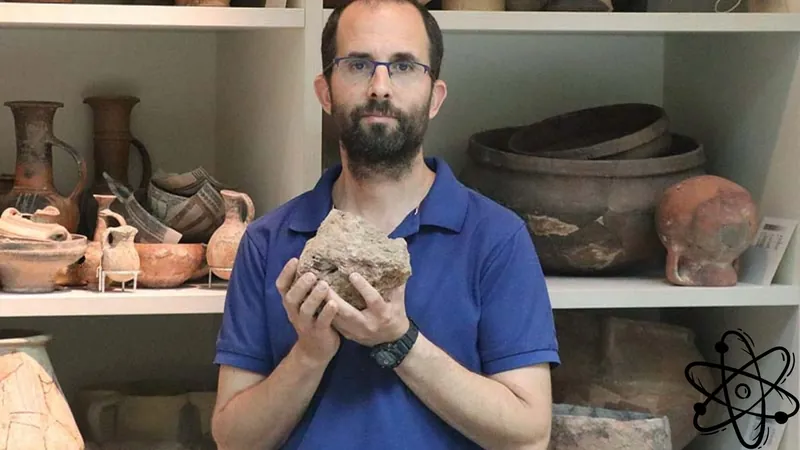
Unraveling the Past: Scientists Validate Ancient Biblical Battles with Innovative Magnetic Dating Technique!
2025-01-20
Author: Ling
Unraveling the Past: Scientists Validate Ancient Biblical Battles with Innovative Magnetic Dating Technique!
In a groundbreaking new study, researchers have leveraged a revolutionary technique to authenticate pivotal events from the Bible. Utilizing archaeomagnetic dating—a method that investigates Earth's ancient magnetic field recorded in archaeological materials—scientists have forged credible evidence affirming the accuracy of numerous significant happenings chronicled in the Hebrew Bible.
This merger of archaeology and geophysics is not merely shifting our perspective on history; it is redefining the timeline of ancient military conflicts, city destructions, and our understanding of the Earth’s ever-changing history.
What Is Archaeomagnetic Dating? The Science Behind It
Archaeomagnetic dating is a method focused on analyzing magnetic minerals found in materials like ceramics and mud bricks that undergo intense heat. When these substances are heated during events such as fires, they capture the Earth's magnetic field at that specific moment in time.
By examining the arrangement and intensity of these magnetic minerals, scientists are able to construct a timeline that dates ancient destruction events. Combined with traditional archaeological practices and radiocarbon dating, this method enhances our comprehension of historical events and their timing.
A Major Confirmation: King Hazael's Campaign
Among the key revelations from this study is the confirmation of military campaigns led by King Hazael of Aram-Damascus, a prominent figure referred to in both biblical and secular histories. Prior research had posited that Hazael's campaign led to the destruction of various sites, including Gath of the Philistines, Tel Rehov, Tel Zayit, and Horvat Tevet.
By studying the magnetic records from these archaeological sites, researchers have established that all four locations were indeed annihilated during the same military expedition, approximately around 830 BCE. This finding not only corroborates biblical and historical records but also highlights the extensive reach of Hazael’s conquests—an area of debate among scholars for years.
A Surprising Update: The Timeline of Tel Beth-Shean's Fall
Interestingly, this study contradicts prior assumptions regarding the fall of Tel Beth-Shean. Earlier suggestions attributed its destruction to Hazael’s campaign; however, the magnetic signatures from this site indicate that the destruction occurred 70-100 years earlier, aligning it with military actions by Pharaoh Shoshenq. This adjustment is further supported by Egyptian inscriptions and various scriptural mentions, providing a revised historical framework for conflicts in the Southern Levant.
Exploring Judah's Downfall: Insights from Archaeomagnetic Data
The collapse of Judah in 586 BCE, documented in biblical accounts, has been a prominent topic of historical scrutiny, often focusing on the Babylonian role in this downfall. Yet, recent findings via archaeomagnetic dating unveil an intricate tapestry of events.
While Babylonian forces were undoubtedly integral to the devastation of many cities in Judah, the data uncovers that other sites were destroyed by Edomite forces—an aspect briefly mentioned in the Scriptures but frequently overlooked by historians. This indicates that the Edomite invasion occurred after the Babylonian conquest, providing a richer understanding of the political dynamics during Judah’s decline.
Shocking Discoveries: Earth's Magnetic Field Dynamics
Beyond its biblical significance, the research bears vast implications for our comprehension of the Earth’s magnetic field. For decades, scientists have theorized that changes to the magnetic field occur slowly. However, the archaeomagnetic evidence from this period reveals rapid fluctuations, with some regions experiencing magnetic intensity more than doubling.
These findings challenge previously held beliefs, suggesting that the Earth’s magnetic field is significantly less stable than once thought and that dramatic shifts may have transpired more frequently in antiquity. Understanding these geological changes is vital for refining models of Earth’s core dynamics and predicting future geophysical events.
Looking Ahead: The Impact on Science and Future Research
This innovative study reshapes our grasp of ancient biblical occurrences and opens up expansive avenues for archaeological and historical exploration. By amalgamating archaeomagnetic data with conventional archaeological techniques, researchers now possess a remarkably potent method for testing and refining historical hypotheses with unmatched accuracy.
As this methodology continues to improve, it will likely be applied across various regions, unveiling new insights into the ancient world while validating—or challenging—established historical narratives.
The integration of archaeomagnetic dating has proven transformative for our understanding of ancient history. This cutting-edge technique reaffirms crucial biblical events, revises historical timelines, and enriches our knowledge of the Earth’s magnetic dynamics. As research advances, we can anticipate a more nuanced understanding of our past that could reshape established beliefs and historical accounts!


 Brasil (PT)
Brasil (PT)
 Canada (EN)
Canada (EN)
 Chile (ES)
Chile (ES)
 Česko (CS)
Česko (CS)
 대한민국 (KO)
대한민국 (KO)
 España (ES)
España (ES)
 France (FR)
France (FR)
 Hong Kong (EN)
Hong Kong (EN)
 Italia (IT)
Italia (IT)
 日本 (JA)
日本 (JA)
 Magyarország (HU)
Magyarország (HU)
 Norge (NO)
Norge (NO)
 Polska (PL)
Polska (PL)
 Schweiz (DE)
Schweiz (DE)
 Singapore (EN)
Singapore (EN)
 Sverige (SV)
Sverige (SV)
 Suomi (FI)
Suomi (FI)
 Türkiye (TR)
Türkiye (TR)
 الإمارات العربية المتحدة (AR)
الإمارات العربية المتحدة (AR)